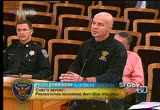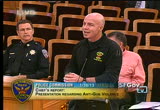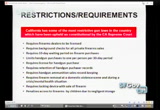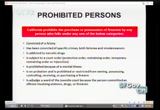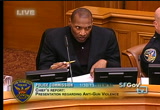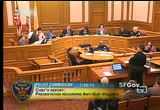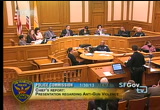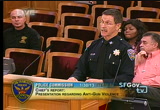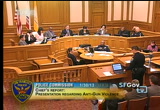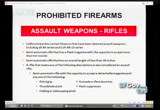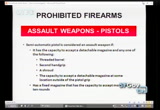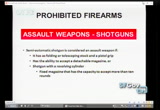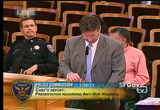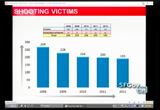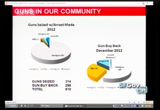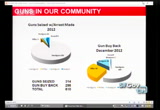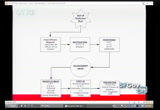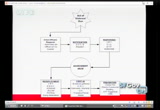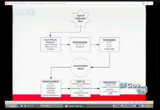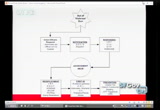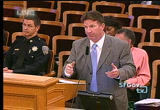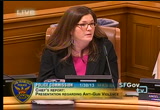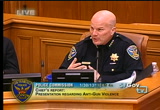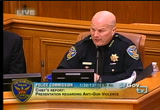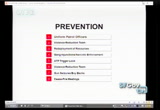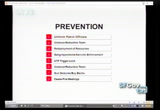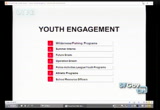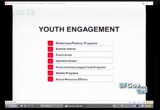tv [untitled] January 30, 2013 8:00pm-8:30pm PST
8:00 pm
other ones? >> the hallow point is designed as a human stoper, it is designed to stop humans that is what that bullet was designed for. it was designed to expand in tissue. so when that round hits a person, it spreads and it causes more damage, on entering that person. it is designed as a hallow point and it is destroyed and i don't want to get graphic but it destroy the tissue in the human body. having said that, other bullets full metal jacket like some are that not proposed to be illegal can cause a lot of damage. they penetrate even further, for example, if a police officer were to use that in a home or someone using a full metal jacket bullet in their
8:01 pm
home and it may penetrate through several walls and cause more damage than a hallow point, i don't know if that is really the answer to, i don't think that it really makes a difference and the bullet is dangerous. >> the mayor was talking about black talon. >> that is the one that i was talking about that has a jagged edge and it is mainly to destroy more human tissue and to stop the threat of whatever, you know. >> i didn't realize that the black talon was the same as the hallow. >> it is hallow and it has several different designs and that is just one particular design that they have. again, a bullet is inherently dangerous and a hallow point may not be more dangerous than a regular, full metal jacket in my opinion. >> thank you. >> thank you, officer. >> thank you for your time. >> well as you can see he is truly an expert and he loves
8:02 pm
what he does and i thank him for that explanation, that was like an 8-hour class that we got in 20 minutes. and moving on will be the captain and he will give an overview of the gun laws in the state of california. >> good evening, commissioners, chief, director. thank you very much, i'm dennis oleary from the chief's office. first i would like to let you know that the question was what are the four more commonly enforced gun laws in san francisco? and now, commissioner mazzucco they have changed the laws and the numbers are different. so what used to be like 12025, and 12031 is now a new series. but any way, the most common guns are carrying concealed with firearm and carrying a loaded firearm, someone that is prohibited from carrying a gun is caught carrying a gun and
8:03 pm
then carrying a stolen gun and that is what the 496 charge is. and california has like angela was saying, has some of the most restrictive gun laws in the state that makes it and it is difficult to buy a gun, where people have to in california, the firearms dealer has to be licensed and there is background checks and ten-day waits. that has been standard for many years. and there are limits on how many guns can be purchased and it goes on about the record keeping and particularly it talks about our gun laws penalize access for children due to negligent storage. so there was mention of the new york law, i believe was modeled on the california law. and there are two like, you can own a gun in california.
8:04 pm
but there are two, there are people that cannot have a gun and there are certain guns that you cannot have. so in california, it prohibts certain people from having a gun, if you are a felon or if you are an addict you cannot have a gun. if you are subject to a court order, while that is in effect, you can't have a gun. whether it is a restraining, order or an injunction you can't have a gun if it says so, also if you have a history of mental illness you can't have a gun. also if you are probation and the probation says that you can't have a gun, then during the course of your probation, no gun. and also, it is not that well known, but if you are a ward of the juvenile court because of
8:05 pm
an offense you cannot own a gun until you turn 30 years old. >> any questions about that part? >> yes, sir? >> captain, 496 is not a specific gun provision, though, it is a general prohibition against stolen property and often the guns are stolen property,; is that correct?? >> correct. >> it is just a charge that we get a lot of stolen. it is like the fourth most common charge for somebody put on a gun. if it is a charge higher than the other three,... >> the exposure for the 496 i think is 16 months and up to four years. >> two or three. >> two or three, thank you. >> i just have one question and
8:06 pm
this might be a better question for the chief. but, we are talking about arm and prohibited persons and i know that the california department of justice has the apps list which tell us what people in san francisco are armed and prohibited from having a weapon. with the staffing issues the department of justice did sweeps to get the guns from other counties, i don't think that they worked with us. >> they did. we did too. >> okay, great. and is there any interest in renewing that effort? >> yeah. i mean, we did, we scooped up quite a few guns. >> okay. >> i know that several of them came out of the bay view at the time when i was at the bay view. >> okay. >> in fact when jerry brown left the attorney general's office, just at the end of his tenure, the list came out and it was so large, that it was
8:07 pm
desiminated and they would use the officer on patrol to locate the people and the guns. >> it is not an easy thing, these are people that are armed and prohibited from being armed and so there is officer safety issue and you need to have a large term. i know that on an ongoing basis, we are advised for the people in the county. for us to be thinking about in terms of supporting the department, that certainly is a high priority and not something that is easily done, and to the extent that we could do that to the ongoing ba sis would be great. and i know that it is resource heavy. okay. so that pretty much dedescribes the people that can't have a gun. now there are guns that you can't have and officers? >> the people on the people that can have a gun? >> sure. >> you said that your presentation said that those addicted to narcotic drugs, how is that judged? by some type of court order? >> or?
8:08 pm
>> the judge says, tell us that the person is an addict. >> that is usually in the probation. >> where is this information sent? once a person has been adjudicated, to be addicted to narcotics and no longer able to have a firearm, where? >> california has a data base, a cini, data base and that is where the data base that an officer will conduct an investigation for local, state and national and international sometimes. and it is there at the state level, that it can be found. >> and anybody that fits into any fp the categories that you listed they all go to the same place, they are on the same
8:09 pm
list. >> yes. >> if i could just say what they did which was smart here, on the attorney general's office, here is the list of the people that are prohibited and this is the list of people that have guns and why don't we put the two lists together which is amazing, and i could get a gun and in a year later i am convicted of domestic violence and i am no longer able to have that gun, but there was not an mechanism absent of a officer going to the house and retrieving that weapon. that data is there and the ongoing issue is the resources for the documents especially on the local level for everybody to get out and do that in the way that is safe for the officers. >> good point, thank you. >> and then there are certain guns that you cannot possess. and so we had a presentation that talked about the rifles and basically ak series, and ar series, the cult ar series you
8:10 pm
are prohibited from possessing them. the semi, automatic rifles with the fixed magazine, that will take more than ten rounds. a 30, something that has less than 30 inches of length. and then, there is, there are the law gives us describes features on a gun, that makes it an assault rifle, things such as a pistol grip. different kinds of stocks, a full meter stock and a grenade or flare launcher, these are military items and a flash suppresser, of these that i show you, the one that is going to be the greatest and the ones that will be the greatest danger to the public are the folding stock, and the flash suppresser. the folding stock makes it more concealable and the flash suppresser makes it concealable when it is being used. you cannot see the round and
8:11 pm
the officer cannot locate the suspect because of the flash. there is no flash. and so, that is why, you know, these laws are in effect. so what makes a gun, an assault weapon, a pistol on assault weapon. well, it, again, goes to having a threaded barrel and that has to do with not only the ability to accept a silencer, but the ability to access a flash suppresser. the secondhand grip that you can see that in some of these pictures and angela showeds you some of these guns, a shroud, one of the weapons that i showed you showed the shroud. itself allows the shooter to put his hand on the barrel and if the barrel is hot, they when you fire some of these guns, there is a propensity for the gun to go up and you put your hand on the second pistol grip or the shroud you can bring it down and improves the accuracy, and it allows you to put your
8:12 pm
hand on a hot barrel because it is ventilated. so these are weapons that have been described as assault weapons. and also, the capacity to accept the magazine somewhere else than from the grip. and we saw it in the an example of that. and also, that we come back to the magazine that has or can take more than ten rounds. so, it has the capacity to accept a magazine more than ten rounds. shot guns, are also assault weapons, if they are again, the foldings stocks, a pistol grip and to accept the detachable magazine or a shock with the revolving cylinder, that is what they called the street sweeper, it is a wicked looking magazine. and it can just put out round after round after round. so, i told you, about our gun laws, and about who can't have a gun, and what guns can't be
8:13 pm
possessed. thank you, is there any questions about that? >> thanks. >> thank you. >> thank you very much. >> that is great presentation, thank you very much. captain. >> okay, so now we talked about weapons, and we talked about our gun laws and now, i am going to have captain joseph mcfaden is going to address you and show you number one how we track gun violence in our city and also how we respond to an act of violence involving a act of a weapon or a gun in our city. thank you. >> president mazzucco, commissioners, director hicks good to see you. i have been in front of these commissions just over the past several years for different reasons, mostly, that was a ois director that sergeant crudo now has. >> the first picture that i am showing you here is of our shooting victims' list, dating back to 2008.
8:14 pm
and upwards to 2012. and we have this steady decrease from 2008 of shooting victims. as you can see in the top chart there, out of the 147 victims, of 2012 that were shot in san francisco, we had 46 that died with the total of 193, however, there has been a slight decrease over the years since 2008 of shootings, that can be associated to whether sometimes people will point to sfgh or medical care that is provided directly upon the shootings, some of these victims walk in and are provided medical attention and a lot of them are surviving. some people say bad shots, whatever you might want to think, but that is our stats now for shooting victims for 2012, all wait from 2008. >> the next thing that i want to talk about is the tracking and cases and i am just going to show you something that i have here. here is a list, and it is 9
8:15 pm
pages long with about 36 people on each page and these are just the arrests with firearms of people that we find in the city of san francisco and this is just for 2012. so out of this, there were 314 guns seized in arrests in 2012 of the people on the streets and some of them gang members and others caught with weapons. and here is our, here is the break down in a pie chart basically of what we have. you can see the amount and the big part of the pie is our hand guns. accounting for 292 of them were hand guns at some point in our investigations. the small number of them, you can see the assault weapons, there were 9, shot guns, ten and rifles three, and i want to point out that our total went up, extremely in one day by at least one man's work that i can point to, dr. marshal had the
8:16 pm
gun buy back program and we got 296 weapons returned in one day, and a great work on his part with getting or helping us on that. and we had to go out and get more money to pay off the people that return these guns, which was a great effort to almost equal less than the arrest with just one day of work. and this is not, and this is just ones of the arrest that we are talking about and 314 and there are other weapons that are seized at different crime scenes or found, a lot of times these guns are found in abandoned vehicles and house and people report them in back yards when we find them and we try to track those and try to find out if we can associate them with a crime. >> excuse me. >> we also track them, there is a board at dc beal's office that tracks the homicides and shootings every day. and that goes back to 2008 and it is a big white chalkboard that each day updated daily,
8:17 pm
whether we have shootings, homicides and that way the chief and the deputy chief can look at our response in what we are doing. here is currently our system by which we are respond to the 217s. we call them, the shootings out on the streets on a daily basis. i know that it is a small chart and hard to see on this, but basically when an act of violence or gun use occurs, you have the initial officers that respond after the scene, and when the initial officers get there, they are going to administer aid to the victim and have one go to the hospital with them and if they make fire and they can get a dying declaration and be there for support and get a statement about who did this. >> as this happened, a notification gets made for the dispatch center and notified for our doc. our unit down there. and what happens is our doc will then notify, you are going to hear it on the radio and so
8:18 pm
we already have these vrt units in the third boxes, the responses and so the violent reduction team unit and the crime investigation units and our gang task force and homicide unit all respond depending on what the severity is. obviously if they died, the homicide will go out there. once the people get there and once the initial officers and the violence reduction teams get there, there is going to be an assessment made. they are going to try to acquire education or knowledge about what happened there and whether it was gang related. currently if that happens, and we have gone through this past weekend as soon as there is an assessment made of the situation, whereby we believed that it was gang related. we will do the redeployment and each week we sent out a schedule and it goes out to the violence reduction team and our swat team and our honda unit and it puts our trouble hot spots on the map and it is not
8:19 pm
only for gang involved shootings, but for robberies or different crimes that are occurring during the weekend so we want to sat rate these different areas and so i break it down across the board. a lot of times these lieutenants are the captains of the certain districts they called and needed help on the robbery issues. so we are going to sat rate that area, and things of that effect. we are going to be sat rating some of our areas with gang problems. what we found on this past week and we seen it several times and there is a retaliation. we broke down and redeployed to the double lock and the sunny dale thinking that there will be retaliation from other gangs and all of the units will be dispatched through and contact me directly after a shooting and i will notify the commander and up the chain all the way to
8:20 pm
the chief and direction that will come back down and the head of the brt unit or the crime investigations unit will contact me and i will call doc and tell them to redistribute the units where they are going and to notify the dispatch about where they are at. it is an immediate response to what is going on and hopefully it will take down any retaliation, and any more gunfire that happens immediately after one of these shootings. within the first 48 hours, the bottom box in the middle, that is when we have and we bought time but our ciu units or gang units or our homicide units that is when most of the investigation is happening. that is when csi evidence is gather and when we have the interviews done and that is when we have informants or any other evidence that we can gather to find out who was involved in the shooting and how to curtail it by getting a suspect in custody as soon as possible. that is also when we are meeting with the district attorney office to see if we can identify who did it and if
8:21 pm
they have any probation or parole status and also that might be the area that we most likely will involve the media, if we are looking for somebody. or if we are trying to find any witnesses to the crime that occurred over the weekend or within the past couple of days. as for prevention, the prevention part of it, which deputy chief deal will get into it a little bit. one of the things that we do we will have a sees fire meeting in two weeks, it is when we meet and we meet all of the under cover unit and probation and parole and we go over those areas and those people that were most looking for, whether they be gangs or suspects and robberies or shootings and homicides. so it is almost on this every two week basis looking at and reanalyzing where we need to put our resource and going after the people that we need to arrest. that is also when we might meet with the district attorney and that is when the community gets involved with the community
8:22 pm
resource network and that is when we are out reaching to them to let them know that this happens. it happens at the district meeting level that the captains are going to have within each district to kind of assess and give direction to the community to see if we can't get the witnesses through the community. we also work with atf on these trigger lock cases and things of that effect. are there any questions that you might have? >> just wanted to ask the chief, chief, you mentioned after the summer, with the shootings and the homicides, the string of those was in like 6 weeks, that you guys had deployed some different tactics and you talked about the zone. this might have been something that you were doing all along. i just want to be clear. was any part of this new and it has been very effective. >> so going back to pretty much the 80s. we used to deploy what was called area strategies with the pencil and counting and that
8:23 pm
became an area strategy in the early 2000s, mid 2000s and, then that was even heard more by deputy chief and commander murphy in right around 2009. and where we actually had that and started to get this piece dividend that we have been having since and in last july after we had the violent june in the vis valley and the violent weekend in july and the mayor convened a group and we came up with interrupt and predict and organize his ipo strategy and we took the whole zone strategy and married it to sort of a task force response and of course the tech piece which are the blackberris that we are all slaves to right now allows for rapid deployment and engagement for both the captain's major crimes unit folks as well as parole all at the same time and literally,
8:24 pm
you know, 24/7, 365 which netted us the first homicide free august in 30 years and had us about 40 percent our monthly average for the first seven months of the year was 40 percent higher than it was the last five months of the year. so we are hoping to carry that through, again, we have staffing challenges for 2013 that this body acting on the mayor's plan will, you know, be seriously addressed going forward into 2014. but it will still be on the down side in 2013. so all of these efficiencies and deployment strategies we can't have enough of them and the officers have been so terrific about changing hours and working more nights and weekends and all of the bosses kind of not with the ego and figured it out and it has really paid off. >> thank you, captain. >> thank you. >> excellent, presentation. >>
8:25 pm
>> so now moving on i am going to give the piece on prevention, our community engagement with the youth, and our education piece between the community and our office internally and externally. so let's begin with the prevention piece. obviously, the back bone of our or any department is our uniform patrol, we have 24/7, we have officers out there on patrol in the radio cars and walking foot beats. we have violence reduction teams and vrt teams and the ten officers and two sergeants, they respond rapidly to any situation, hot spots and they do the saturation for us and allow us to really be very mobile with what we are doing on a daily and nightly basis in a very quick deployment schedule. >> we also have gang injunctions as you know, we have the narcotics enforcement and we have plain clothed officers that are continuing to
8:26 pm
work plain cloth in all of our district stations. we have the sees fire meetings as the captain earlier alluded to and we also worked with the mayor's ipo process, that is always on the top of our level, right in the front and the heart of our violence reduction strategies. with that, we have officers that work with the atf to bring the gun cases. and we do all ballistic testing with all of the weapons that we recover and we enter them into a national data base called the international ballistic network or nibin and that is the information data base established by the atf and also now recently with the gun buy back, that is all part of the piece of the prevention piece. with the youth engagement, pal has been around for 50 or 60 years now, and all of us were
8:27 pm
in the pal at one time and as the police officers and the volunteers coaching kids and working with kids. we want to engage the youth at a critical time in their lives between the ages of 12 and 18, where they are vulnerable and we want to make sure that they build the relationships and the bridges at the police department and get to know the officers on a personal level and see the officers being just regular people like they can talk to and work with. we do that, through the wilderness program and we take the kids camping and the program will take the kids out fishing and i know that the chief is always going to all of the little schools and high school of the future program and encouraging the kids to graduate from school and explain to them the difference in their life that it is going to make and keep them safer and it is going to help them get better jobs and make them more fulfilled. so we always try to get kids to graduate from high school and move on to college and the chief has also worked with our sfpd foundation to create a summer jobs program and all of
8:28 pm
us have heard of operation dream. operation dream, we work with the 49ers and we gathered thousands of toys every year like christmas time we can bring christmas to a lot of kids that needy, and be able to fulfill some of their wishes and be a part of their families through operation dream. we have basketball, and i personally run a basketball jamboree for little schools and we have internships through the police department and we have school resource officers in every school. and always interacting with the kids and school faculty. through education, i will give you a little idea of what we do internally and externally. internally, our academy has 33, for 31 weeks for all of the recruit officers and there they are trained in a week, long training of officer, safety and field tactics, they get, active shooter training and continued
8:29 pm
professional training for all of our officers, every two years, they get a two hour, update in the classroom. on gun strategies and also safety strategies, we have the cit or crisis intervention training for the officers and so that is just a small piece of what we are doing internal sxli let alone not the piece that we do with the post. >> externally we have the citizens that work with the community and all of our district station captains attend the community meetings and regular community meetings and we have the cpads which is community, stands for community leasing advisory boards. we have our police forums, and we have community forums and we have public service announcements that the chief does through the radio, to educate people on being safe in the street. and it is something that is continual. and it is ongoing. and we will be working with all of these processes right now to not only provent violence right
61 Views
IN COLLECTIONS
SFGTV: San Francisco Government Television Television Archive
Television Archive  Television Archive News Search Service
Television Archive News Search Service 
Uploaded by TV Archive on

 Live Music Archive
Live Music Archive Librivox Free Audio
Librivox Free Audio Metropolitan Museum
Metropolitan Museum Cleveland Museum of Art
Cleveland Museum of Art Internet Arcade
Internet Arcade Console Living Room
Console Living Room Books to Borrow
Books to Borrow Open Library
Open Library TV News
TV News Understanding 9/11
Understanding 9/11